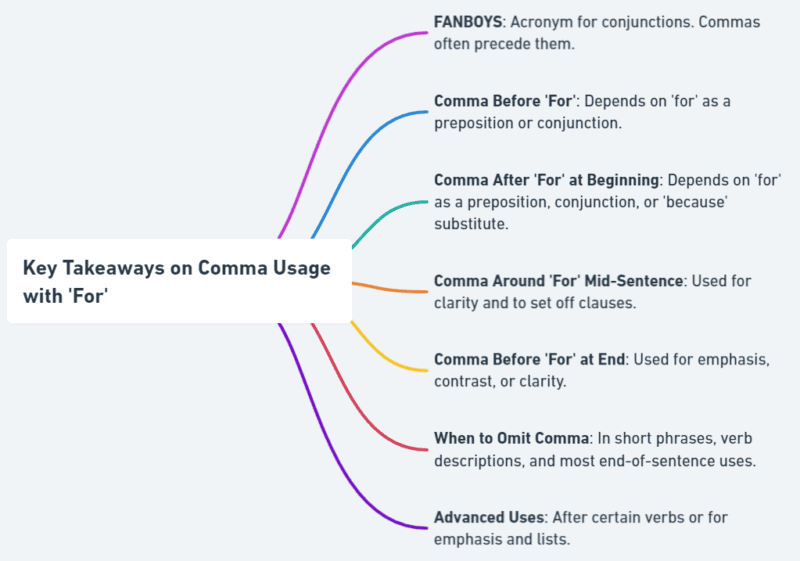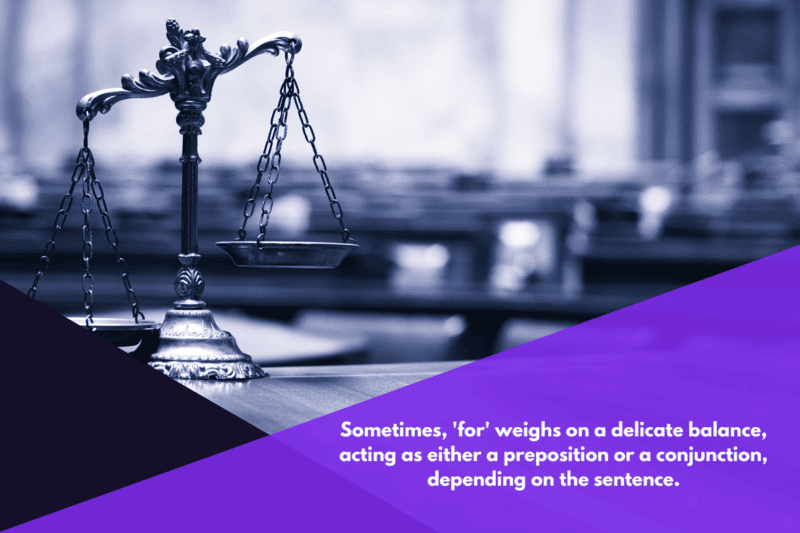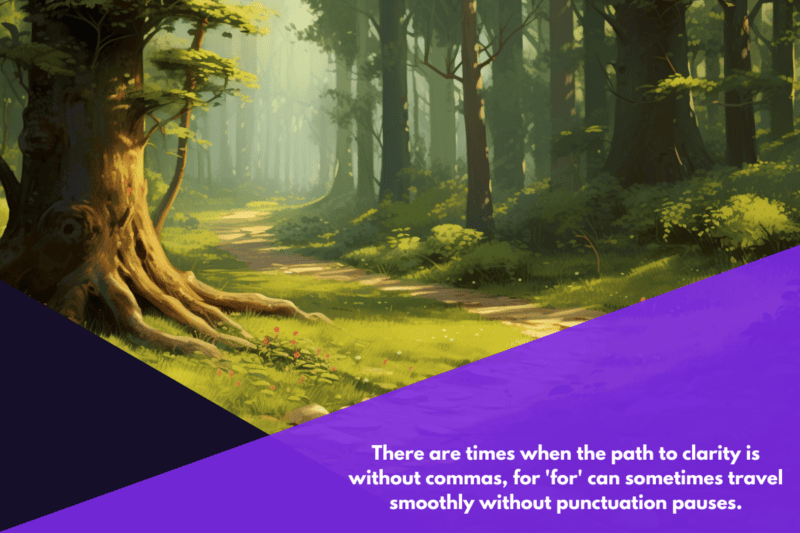It’s the moment every writer dreads. You’ve crafted a beautifully worded sentence but then pause with your finger hovering over the comma key. Do you put a comma before “for”? Or would that disrupt the flow?
These hesitant heartbeats, dear reader, are why we must understand the deeper comma wisdom surrounding this common little word.
So take a breath. Together, we will unravel the mysteries of “for,” arm ourselves with knowledge and punctuate with purpose.
Let’s dive in, shall we?
But first, the short answer, because I’m nice like that, and so you don’t have to slog through the whole article if you don’t want to:
The use of a comma before “for” depends on its role in the sentence. If “for” is a coordinating conjunction linking two independent clauses, a comma is usually used before it. However, if “for” serves as a preposition, it typically doesn’t require a comma.
If that’s way too confusing (don’t worry, it was for me at first, too), then read on for a more in-depth explanation and examples. Lots and lots of examples.
Table of Contents
Key Takeaways
| Topic | Key Takeaways |
|---|---|
| FANBOYS | – Acronym for coordinating conjunctions: For, And, Nor, But, Or, Yet, So – They join together parts of a sentence – Comma often needed before them to avoid confusion |
| When to Use Comma Before “For” | – No comma when used as preposition – Add comma when used as conjunction between independent clauses |
| Comma After “For” at Beginning | – Usually no comma when used as preposition – May/may not need comma when replacing “because” – Add comma when linking clauses as conjunction |
| Comma Around “For” Mid-Sentence | – No comma for prepositional phrases – Use commas to set off clauses – Add for clarity as needed |
| Comma Before “For” at End | – Usually don’t need a comma – Use if needed for emphasis, contrast, clarity |
| When to Omit Comma | – With short phrases like “for now” – When describing a verb mid-sentence – In most end-of-sentence uses |
| Advanced Uses | – No commas when used after verbs like “opted” – Add commas when used for emphasis, lists, etc. |
| Key Rules | – Varies by use of “for” as preposition vs. conjunction – Consider sentence position and flow – Use commas for clarity as needed |

FANBOYS Explained

Before examining when to use a comma before “for,” it helps to understand what FANBOYS stands for. FANBOYS is a handy acronym for the coordinating conjunctions: For, And, Nor, But, Or, Yet, So.
These conjunctions join together parts of a sentence. We call them coordinating conjunctions because they coordinate or link words, phrases, and independent clauses that are balanced or similar grammatically.
Example: Jessie loves popcorn, and she enjoys going to the movies.
Example: Will you make dinner, or should we order takeout?
Here, “and” and “or” are coordinating conjunctions connecting two independent clauses about Jessie’s interests and options for dinner.
When a coordinating conjunction like “for” links two complete thoughts together, you typically need a comma before it to avoid confusion. Otherwise, your reader gets lost in a jumble of words!
However, comma rules vary for each FANBOYS conjunction. While we’ll focus just on “for” here, you can learn about punctuating all these handy words in our guide to comma usage with FANBOYS. Also, check out this article on commas with “and”, as well as this one covering comma usage with “but.”
Now that we’ve covered the basics, let’s break down when and when not to use commas with “for.”
When to Use a Comma Before “For”

Unlike other FANBOYS words, “for” pulls double duty. Depending on the context, it can be either a preposition or a conjunction.
As a preposition, “for” shows direction, purpose, or timeframe.
Example: We left for the airport at dawn.
Example: I bought this jacket for you.
Example: We’re saving for retirement.
In these sentences, “for” acts as a preposition showing the trip’s destination, the gift’s intended recipient, and the financial goal.
As a conjunction, “for” connects phrases and clauses.
Example: We went to the diner, for we were hungry.
Example: I studied all night, for I had a big test in the morning.
Here, “for” acts as a conjunction linking two independent clauses about why the subjects went to the diner and studied.
When used as a preposition, “for” typically doesn’t need a comma. However, as a coordinating conjunction joining two independent clauses, it requires a comma before it.
Let’s examine some examples showing “for” in action:
| Example | Part of Speech | Comma Necessary |
|---|---|---|
| For the fifth time today, my computer froze. | Preposition | ❌ |
| My computer has been freezing all day, for it is quite old. | Conjunction | ✔ |
| We headed out early, for the hike was longer than expected. | Conjunction | ✔ |
| I bought this jacket for you. | Preposition | ❌ |
| There are reasons for and against this proposal. | Preposition | ❌ |
| I searched everywhere for my keys. | Preposition | ❌ |
| He stayed up late studying, for he had a big test in the morning. | Conjunction | ✔ |
Do You Need a Comma After “For” at the Beginning of a Sentence

When “for” appears at the start of a sentence, comma usage depends on how it’s functioning and the structure of the clause that follows.
As a preposition, “for” starting a sentence typically doesn’t take a comma:
Example: For years, we dreamed of visiting Paris.
Example: For now, we will stay here.
However, as a subordinating conjunction replacing “because,” “for” may or may not need a comma:
Example: For you were sleeping, I let the dog out early. (comman needed)
Example: For the rain stopped, they continued their picnic outside. (no comma)
And when used as a coordinating conjunction, a comma is required after “for” at the beginning of a sentence:
Example: For the hike was longer than we expected, we left early. (comma needed)
Example: For we were famished, we went straight to the diner. (comma needed)
In rare cases, you may need a comma after “for” at the start of a sentence for emphasis or to offset an interjection:
Example: For, in my opinion, this is a mistake.
Example: For—believe it or not—he juggled three balls while riding a unicycle!
But in most situations, just follow the standard rules outlined above when “for” begins a sentence.
Do You Need Commas Around “For” in the Middle of a Sentence?

When “for” shows up in the middle of a sentence, the rules are slightly different.
As a preposition, “for” doesn’t require a comma when describing a verb phrase:
Example: Jess cooked dinner for over an hour.
Example: We searched for the missing document all morning.
However, as part of a dependent clause, “for” may need commas to set it off:
Example: The proposal, which we worked on for over a month, was approved.
Example: His birthday, for which we had been planning a surprise party, was today.
Sometimes commas can provide helpful clarity with “for” mid-sentence:
Example: Sam, for example, is an excellent cook.
Example: The shelf, once sturdy, now leaned, for it hadn’t been properly installed.
But in straightforward sentences, resist the urge to plop in unnecessary commas with “for.”
Do You Need a Comma Before “For” at the End of a Sentence

When “for” comes at the end of a sentence, omitting commas is usually correct:
Example: We left early because we had to find the keys we were looking for.
Example: She’s the one I’ve been waiting for.
Example: These are the ingredients you asked for.
When Not to Use Commas with “For”

Now that we’ve covered situations requiring commas with “for,” let’s look at times when commas should be omitted.
With Short Prepositional Phrases
Very short prepositional phrases starting with “for” typically don’t need commas:
Example: Jess left for now.
Example: Check back for updates.
Example: This is for you.
In these examples, the phrases “for now,” “for updates,” and “for you” briefly explain the purpose without disrupting the flow. Adding commas would create unnecessary choppiness.
Let’s examine a few more cases where commas can be left out with short “for” phrases:
Example: I’m leaving for the day.
Example: We’re saving that discussion for later.
Example: Everything is ready for tonight.
Example: We waited for hours.
Example: I made this quilt for my niece.
However, if the phrase feels like a strong interruption or aside, you may need commas:
Example: I’m leaving, for now, but I’ll be back later this week.
Example: The proposal was approved, for the time being, though changes are likely.
When in doubt, read the sentence aloud — your ear will pick up on phrases that need to be set off.
Mid-Sentence and End of Sentence
As mentioned earlier, “for” used as a preposition mid-sentence or at the end generally doesn’t take a comma:
Example: Jess cooked dinner for over an hour.
Example: We searched for the document all morning.
Example: I can’t find my wallet anywhere for the life of me.
The commas in these examples would sound disjointed and interrupt the flow.
Resist the temptation to add unnecessary pauses unless “for” is part of a non-essential clause or used for emphasis:
Example: The proposal, which accountants worked on for over a month, finally got approved.
Example: I simply cannot find my wallet anywhere, for I’ve searched thoroughly.
In most cases, though, you can confidently omit commas with “for” in the middle or end of a sentence. Trust your ear and go with the flow.
If you want to learn more about commas, check out this article on using a comma with “please” and this one on using commas with “yeah.”
Advanced Comma Uses with “For”

Now that we’ve covered the basics, let’s move on to more advanced comma scenarios with “for.” This tricky conjunction has a few more grammar tricks up its sleeve.
“For” Referring to “Pros” and “Cons”
“For” can also mean “in favor of” when discussing the pros and cons of something:
Example: There are reasons for and against this proposal.
Example: We weighed the arguments for and against the new policy.
Here, no commas are needed.
“For” After Verbs
When “for” follows certain verbs like “opt” or “aim,” commas are generally not used:
Example: Jess opted for the vegetarian meal.
Example: We’re aiming for a July launch date.
In Idiomatic Phrases
You’ll also see “for” pop up in idioms like “once and for all” without commas:
Example: I wanted to settle this debate once and for all.
Example: He plans to confess once and for all.
Special Cases: Comma Usage with “For”
Now let’s cover some exceptions to the standard comma rules with “for.” In certain situations, commas are required to add clarity.
| Special Case | Example |
|---|---|
| For Emphasis | This project, for one thing, is my top priority. You should go, for heaven’s sake, before it gets any later! |
| To Avoid Ambiguity | For baking, you need eggs, milk, and butter. (kitchen context is clear) For example, you need eggs, milk and butter. (example versus baking purpose is clear) |
| In a Series | Jess prepared for the party by buying decorations, baking a cake, and making a playlist. |
| With Negative Verbs | I could not, for the life of me, remember her name. He did not, for a second, consider quitting. |
Learn More About FANBOYS and Commas
Go Forth and Punctuate “For” with Confidence!

We’ve covered a lot of ground here! From the intricacies of “for” as a preposition or conjunction, to comma guidance based on sentence position, exceptions, and special cases.
Please refer to this article anytime you’re unsure about comma usage with this tricky little word. Though we’ve outlined the core guidelines, remember that writing is an art. Some situations require you to use your creative judgment as well.
Need a bit more help? Feel free to ask any questions – I’m happy to provide guidance. Now punctuate forth with precision and purpose, my friends! This journey together has prepared you well.
Frequently Asked Questions
When do you put a comma before for?
Put a comma before “for” when it is used as a coordinating conjunction linking two independent clauses. Don’t use a comma when “for” is used as a preposition.
Do you put a comma after for at the beginning of a sentence?
Usually, no, unless “for” is linking clauses as a coordinating conjunction. Then a comma is required after “for” at the start of the sentence.
Is a comma needed around for in the middle of a sentence?
No, “for” used as a preposition mid-sentence generally doesn’t take a comma. But add commas if it sets off a dependent clause or improves clarity.
Should you put a comma before for at the end of a sentence?
Most of the time no, you don’t need a comma before “for” at the end of a sentence. Use one if it adds emphasis or avoids confusion.
When can you omit a comma with for?
Don’t use commas with short “for” phrases like “for now.” Also omit commas when “for” describes a verb in the middle or end of a sentence.

